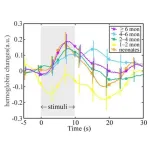(Press-News.org) SAN DIEGO ― Combining the JAK inhibitor ruxolitinib with the BCL-xL inhibitor navitoclax was twice as effective in reducing enlarged spleens – a major indicator of clinical improvement – compared with standard-of-care ruxolitinib monotherapy for adult patients with intermediate or high-risk myelofibrosis, a rare bone marrow cancer, according to results of the Phase III TRANSFORM-1 trial reported by researchers from The University of Texas MD Anderson Cancer Center.
Data from the global, randomized, placebo-controlled clinical trial were presented today at the 2023 American Society of Hematology (ASH) Annual Meeting by Naveen Pemmaraju, M.D., professor of Leukemia. At the time of data cut-off, 63.2% of patients who received ruxolitinib and navitoclax achieved a spleen volume reduction of at least 35% within 24 weeks, compared to 31.5% of patients receiving ruxolitinib plus placebo, meeting the study’s primary endpoint.
“By adding a second drug to an approved therapy, we were able to improve spleen volume reduction compared to the current standard of care. This is an important measurement of the clinical benefits of this novel drug combination because treatments can be less effective when the spleen remains enlarged,” Pemmaraju said. “If we can treat myelofibrosis earlier on in the disease course, we may have an opportunity to impact overall disease modification, improve patient outcomes and reduce symptom burden.”
Currently, there are few Food and Drug Administration-approved drugs for the treatment of myelofibrosis. Available options provide patients with spleen and symptom improvement, but a substantial unmet need remains for therapies that provide durable spleen size reduction and other longer-term clinical. Allogenic stem cell transplants are an effective treatment option, but not all patients qualify.
This international trial enrolled 252 patients with intermediate or high-risk myelofibrosis and measurable spleen enlargement who had not received prior JAK inhibitor treatment. The trial randomized 125 patients to receive the navitoclax and ruxolitinib combination and 127 patients to receive ruxolitinib plus placebo. Most patients were male (57%) and the median age was 69.
The trial met its primary endpoint of spleen volume reduction at 24 weeks. Spleen volume reduction at any time was achieved by 77% of patients on the combination arm and 42% of patients on the control arm. The median time to first spleen volume reduction response was 12.3 weeks with the combination and 12.4 weeks with monotherapy. At 24 weeks, there were no significant differences between the groups in a myeloproliferative neoplasm symptom assessment, a secondary endpoint of the study.
Patients treated with the combination therapy, patients experienced side effects that were manageable and consistent with previous trials. The most common treatment-related side effects were thrombocytopenia, anemia, diarrhea and neutropenia. Serious adverse events were experienced by 26% of patients on the combination arm and 32% on the control arm.
“This study marks a notable achievement in the field of myelofibrosis, as one of the first reported global Phase III frontline randomized combination clinical trials in our field,” Pemmaraju said. “This dataset now opens the door for additional research and investigation into combination therapies to treat myelofibrosis and, importantly, highlights a potential new era of investigating disease modification for patients. Additional data from the TRANSFORM-1 study is being evaluated.”
The trial was funded by AbbVie. Pemmaraju receives research support from AbbVie. A full list of co-authors and their disclosures may be found here.
Read this press release in the MD Anderson Newsroom.
END
ASH: Novel combination therapy significantly reduces spleen volume in patients with myelofibrosis
MD Anderson-led Phase III trial nearly doubled number of patients with spleen size reduction
2023-12-10
ELSE PRESS RELEASES FROM THIS DATE:
ASH: Novel menin inhibitors show promise for patients with advanced acute myeloid leukemias
2023-12-09
SAN DIEGO ― Two clinical trials led by researchers from The University of Texas MD Anderson Cancer Center demonstrated early positive results from novel therapies targeting menin for the treatment of relapsed or refractory acute leukemias with specific genetic alterations. Results from the studies were shared today in oral presentations at the 2023 American Society of Hematology (ASH) Annual Meeting. More information on all ASH Annual Meeting content from MD Anderson can be found at MDAnderson.org/ASH.
Menin inhibitor monotherapy ...
ASH: Targeted oral therapy reduced disease burden and improved symptoms for patients with rare blood disorder
2023-12-09
SAN DIEGO ― The targeted therapy bezuclastinib was safe and rapidly reduced markers of disease burden while also improving symptoms for patients with a rare blood disorder called nonadvanced system mastocytosis, according to results of the Phase II SUMMIT trial reported by researchers at The University of Texas MD Anderson Cancer Center.
The findings, presented today at the 2023 American Society of Hematology (ASH) Annual Meeting, demonstrate that all participants treated with bezuclastinib achieved at least a 50% reduction in markers of disease burden and 63% reported their disease symptoms eased within 12 weeks. That number increased to 78% after ...
New Sylvester cancer study provides insight into underlying gene mutations in myelodysplastic syndromes
2023-12-09
EMBARGOED UNTIL DECEMBER 9, 2023, AT 12:45 P.M. ET
A new study from researchers with Sylvester Comprehensive Cancer Center at the University of Miami Miller School of Medicine and collaborating organizations provides insight into the underlying mechanisms of gene mutations commonly seen in patients with myelodysplastic syndromes (MDS) and other myeloid neoplasms.
Their findings, to be presented at ASH 2023, the American Society of Hematology’s annual meeting in Santa Diego, Dec. 9-12, could lead to development of more effective drug combinations ...
First-in-human clinical trial of CAR T cell therapy with new binding mechanism shows promising early responses
2023-12-09
SAN DIEGO – Early results from a Phase I clinical trial of AT101, a new CAR T cell therapy that uses a distinct binding mechanism to target CD19, show a 100 percent complete response (CR) rate at the higher dose levels studied in the trial, according to researchers from the University of Pennsylvania Perelman School of Medicine and Penn Medicine’s Abramson Cancer Center. The findings were published today in Molecular Cancer and presented at the 65th American Society of Hematology (ASH) Annual Meeting ...
Long-term results show combination treatment that skips chemotherapy is effective for older patients with Ph+ ALL
2023-12-09
Older patients with Philadelphia chromosome-positive (Ph+) acute lymphoblastic leukemia (ALL) who were not good candidates for the standard treatment of intensive chemotherapy had a median overall survival (OS) of 6.5 years on an alternate regimen of dasatinib and blinatumomab.
These long-term results from the S1318 clinical trial will be presented at the 65th American Society of Hematology (ASH) Annual Meeting and Exposition in San Diego on December 9 (abstract 1499).
Anjali S. Advani, MD, a SWOG investigator at Cleveland Clinic Cancer Institute, led the study, with ...
Mindfulness could help women with opioid use disorder better control drug urges
2023-12-09
Mindfulness-Oriented Recovery Enhancement (MORE) — a behavioral intervention that integrates training in mindfulness, emotion regulation strategies and savoring of natural rewards — could hold the key to mitigating relapse in women undergoing medically assisted opioid use disorder treatment, a Rutgers study found.
The pilot study published in the journal Explore, is the first to evaluate the potential neural changes that underlie women’s emotion regulation and craving after an eight-week MORE intervention.
Previous studies have shown that women report higher opioid craving and show a greater inability to ...
TTUHSC’s ARPA-H membership will spur innovation, improve access for West Texas patients
2023-12-09
Imagine if scientists developed a customizable cancer vaccine that was available — and affordable — for everyone. What if a patient scheduled for surgery also had the option of taking a pill whose composition includes nanorobotics capable of performing the procedure?
These and other medical scenarios may seem far-fetched and better suited to a science fiction thriller. However, the Advanced Research Projects Agency for Health (ARPA-H) is seeking to take such ideas from the drawing board to ...
Global annual finance flows of $7 trillion fueling climate, biodiversity, and land degradation crises
2023-12-09
Almost US$7 trillion per year in government subsidies and private investment - around 7 per cent of global GDP - has a direct negative impact on nature.
Nature-based solutions remain dramatically underfunded. Current public and private finance flows are only US$200 billion per year. To meet climate, biodiversity, and restoration targets, this needs to triple by 2030 and quadruple by 2050.
Realignment of public and private nature-negative finance flows is urgently needed
Dubai, 9 December 2022 – Close to $7 trillion is invested globally each year in activities that have a direct negative impact on nature from both public and private sector sources - equivalent to ...
Tracing how the infant brain responds to touch with near-infrared spectroscopy
2023-12-09
Tokyo, Japan – Researchers from Tokyo Metropolitan University have measured how oxygenated hemoglobin levels in the blood change in infants’ brains in response to touch. Using spectroscopy methods with external sensors placed on the scalp of sleeping infants, they found that the time at which levels peak doesn’t change with infant age, but the amount by which it varies over time does. Insights like this shed light on how the physiology of infants develop.
The first phase of a newborn’s life is a dazzling array of rapid developmental ...
These are the world's most effective charities
2023-12-09
Which charities will be most effective in ensuring your donation is put to good use? For the first time in the Netherlands, researchers applied scientific methods to pinpoint which charities achieve the most with the donations they receive. The University of Amsterdam and Stichting Doneer Effectief (Donate Effectively Foundation) unveiled the list on Friday, 8 December, during a sold out evening in Rotterdam. ‘We are talking about the Champions League of good causes,’ says professor of Philanthropy & Sustainable Investment Paul Smeets of the University of Amsterdam. The ranking ...
LAST 30 PRESS RELEASES:
UVA’s Jundong Li wins ICDM’S 2025 Tao Li Award for data mining, machine learning
UVA’s low-power, high-performance computer power player Mircea Stan earns National Academy of Inventors fellowship
Not playing by the rules: USU researcher explores filamentous algae dynamics in rivers
Do our body clocks influence our risk of dementia?
Anthropologists offer new evidence of bipedalism in long-debated fossil discovery
Safer receipt paper from wood
Dosage-sensitive genes suggest no whole-genome duplications in ancestral angiosperm
First ancient human herpesvirus genomes document their deep history with humans
Why Some Bacteria Survive Antibiotics and How to Stop Them - New study reveals that bacteria can survive antibiotic treatment through two fundamentally different “shutdown modes”
UCLA study links scar healing to dangerous placenta condition
CHANGE-seq-BE finds off-target changes in the genome from base editors
The Journal of Nuclear Medicine Ahead-of-Print Tip Sheet: January 2, 2026
Delayed or absent first dose of measles, mumps, and rubella vaccination
Trends in US preterm birth rates by household income and race and ethnicity
Study identifies potential biomarker linked to progression and brain inflammation in multiple sclerosis
Many mothers in Norway do not show up for postnatal check-ups
Researchers want to find out why quick clay is so unstable
Superradiant spins show teamwork at the quantum scale
Cleveland Clinic Research links tumor bacteria to immunotherapy resistance in head and neck cancer
First Editorial of 2026: Resisting AI slop
Joint ground- and space-based observations reveal Saturn-mass rogue planet
Inheritable genetic variant offers protection against blood cancer risk and progression
Pigs settled Pacific islands alongside early human voyagers
A Coral reef’s daily pulse reshapes microbes in surrounding waters
EAST Tokamak experiments exceed plasma density limit, offering new approach to fusion ignition
Groundbreaking discovery reveals Africa’s oldest cremation pyre and complex ritual practices
First breathing ‘lung-on-chip’ developed using genetically identical cells
How people moved pigs across the Pacific
Interaction of climate change and human activity and its impact on plant diversity in Qinghai-Tibet plateau
From addressing uncertainty to national strategy: an interpretation of Professor Lim Siong Guan’s views
[Press-News.org] ASH: Novel combination therapy significantly reduces spleen volume in patients with myelofibrosisMD Anderson-led Phase III trial nearly doubled number of patients with spleen size reduction


